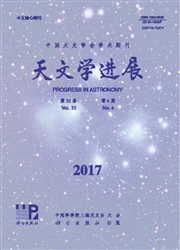

 中文摘要:
中文摘要:
快中子俘获过程(r过程)可以解释大约一半比铁重的稳定(和一些长寿命放射性的)富中子核素的产生,这已经被太阳系及各种金属丰度下恒星的观测结果所证实。为建立r过程模型,需要大量的核物理信息:涉及到β稳定谷与中子滴线之间的各种核素的稳定特性及口衰变分支等物理参数,实验和理论都面临巨大的挑战。综述了近年来贫金属星r过程核合成理论的研究情况,包括人们比较关注的主要C过程与弱r过程核合成、元素丰度分布规律及其产生场所等。
 英文摘要:
英文摘要:
The rapid neutron-capture process (r-process) is traditionally believed to be responsible for the nucleosynthesis of approximately half of the heavy nuclei beyond the iron peak with long-decay half-lives in the solar material. In globular clusters and Galactic halo stars, the observed abundances show a nearly universal presence of r-process. With the rapid development of the abundance determinations, more elements (e.g., Lu, Z = 71) are firstly detected in metal-poor r-process-enriched halo stars, which can be used as the r-process indicators for the early Galaxy. Moreover, these r-rich stars provide a strong constraint on the models of the r-process nucleosynthesis, especially the early galaxy chemical evolution of neutron-capture elements. Based on new atomic lab data, recent neutron-capture abundance comparisons between six r-rich Galactic halo stars and the Solar System r-only abundance distribution indicate that the heavier stable neutron-capture elements beyond Ba (Z ≥ 56) agree completely with a scaled solar system r-process abundance value. Nevertheless, the lighter neutron-capture elemental abundances in these stars are not in agreement with Solar-system r-only values. Although there is controversy over the origin of weak r-process, the neutron-capture elements are proposed to be formed possibly from multiple synthesis mechanisms, even if there exists little uncertainty. Whether the r-process at different astrophysical environments is diverse is also controversial. As needed for the r-process modelling, much effort has been put recently in the measurement of nuclear data of relevance to the r-process, including decay branch characteristics and nuclear stability properties of thousands of nuclides located between the valley of stability up to the neutron-drip line. The challenge is enormous in the theory and experiments of nucleosynthesis. In this paper, a review of r-process nucleosynthesis in metal-poor stars is presented outlining the development of theoretical models and their comparis
 同期刊论文项目
同期刊论文项目
 同项目期刊论文
同项目期刊论文
 Observed Relationship between CO 2-1 and Dust Emission during the Post-asymptotic-giant-branch Phase
Observed Relationship between CO 2-1 and Dust Emission during the Post-asymptotic-giant-branch Phase White-dwarf + main sequence binaries identified from the ninth data release of the Solan Digital Sky
White-dwarf + main sequence binaries identified from the ninth data release of the Solan Digital Sky Evolution of the luminosity function and obscuration of active galactic nuclei: comparison between X
Evolution of the luminosity function and obscuration of active galactic nuclei: comparison between X Formation of black widows and redbacks-two distinct populations of eclipsing binary millisecond puls
Formation of black widows and redbacks-two distinct populations of eclipsing binary millisecond puls Synthetic horizontal branch morphology for different metallicities and ages under tidally enhanced s
Synthetic horizontal branch morphology for different metallicities and ages under tidally enhanced s ?Calculating Method and Characteristics of the Distribution of Neutron Exposures in the Radiative S-
?Calculating Method and Characteristics of the Distribution of Neutron Exposures in the Radiative S- Abundance Analysis of r plus s Stars: r-Process Abundance Comparison between r plus s Stars and r-ri
Abundance Analysis of r plus s Stars: r-Process Abundance Comparison between r plus s Stars and r-ri An explanation of the correlations of abundance ratio between neutron-capture elements and iron grou
An explanation of the correlations of abundance ratio between neutron-capture elements and iron grou Puzzling Origin of CEMP-r/s Stars: An Interpretation of Abundance and Enrichment of s- and r-Process
Puzzling Origin of CEMP-r/s Stars: An Interpretation of Abundance and Enrichment of s- and r-Process INVESTIGATION FOR THE ENRICHMENT PATTERN OF THE ELEMENT ABUNDANCES IN r+s STAR HE 0338-3945: A SPECI
INVESTIGATION FOR THE ENRICHMENT PATTERN OF THE ELEMENT ABUNDANCES IN r+s STAR HE 0338-3945: A SPECI 期刊信息
期刊信息
